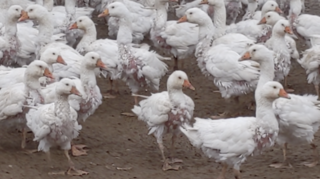Animal welfare NGO FOUR PAWS published on Wednesday footage of geese being plucked alive on several farms across Poland in violation of EU legislation.
The feathers and down are among others used for jackets in the clothing and fashion industry. Only 5% of the globally manufactured down and feathers are sourced responsibly.
The NGO told the Brussels Times that the footage was shared with it by an anonymous source and was taken last year during an undercover operation at 35 farms in Poland. Almost half of them were reportedly forcibly removing down from live geese.
According to an EU directive concerning the protection of animals kept for farming purposes, unnecessary pain, suffering or injury must not be caused to the animals. A recommendation on domestic geese states that "feathers, including down, shall not be plucked from live birds".
However, violations are recurrent. Gathering feathers during natural moulting cycles, when old feathers are shed to make way for new growth is allowed, are a profitable loophole for geese farmers.
“The disturbing footage documents geese vocalising and excessively flapping their wings while being plucked alive, indicating severe pain and distress, with some animals found lying dead,” commented Jessica Medcalf, an expert at FOUR PAWS on animal welfare in fashion.
She added that when geese are in their moulting cycle, it is possible to collect feathers in a lower-impact way. But since not all animals moult at the same time, farmers are motivated to collect as much and as quickly as possible, and this often happens by brutally plucking the birds while still alive.
“A striking finding of the latest investigation is that live plucking is prevalent in parent stock farms. These birds are kept for a lot longer and there is much more opportunity to pluck them alive. We estimate geese kept in parent farms can suffer the severe pain of live plucking 16 times before being slaughtered.”
It is estimated that the global down and feather production volume was around 532,528 tonnes in 2020 with China being the largest export country, producing 70% of the global supply, followed by Taiwan, Poland, the US and Germany.
Some brands are spearheading animal friendly developments by implementing certain animal welfare standards or switching to animal-free alternatives. “Consumers can help by choosing products filled with equally warm animal-free alternatives, or at the very least looking for certified down products,” Jessica Medcalf concluded.

